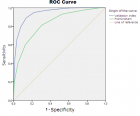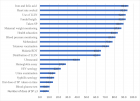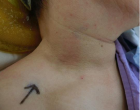Abstract
Research Article
Assessment of risk factors and MACE rate among occluded and non-occluded NSTEMI patients undergoing coronary artery angiography: A retrospective cross-sectional study in Multan, Pakistan
Ibtasam Ahmad, Muhammad Haris, Amnah Javed and Muhammad Azhar*
Published: 30 May, 2018 | Volume 3 - Issue 2 | Pages: 023-030
Objectives: The prime focus of the present study was to evaluate the most occluded coronary artery (OCA) among non-ST elevated myocardial infarction (NSTEMI) patients, and risk factors associated with occluded and non-occluded NSTEMI. Also, major adverse cardiovascular event (MACE) were evaluated among patients during index hospitalization.
Methods: A retrospective, cross-sectional study was conducted in Multan Institute of Cardiology, Pakistan between 1st February, 2017, and 31st September, 2017. The data were collected from medical records of the outpatients and inpatients who were index hospitalized. Data were analyzed by using Statistical Packages for Social Sciences (IBM SPSS Statistics for Windows, Version 21.0. Armonk, NY: IBM Corp.) And Microsoft Excel (MS Office 2010).
Results: Among 624 patients, angiographic findings revealed that 63.9% were suffering from non-occlusive NSTEMI while 36.1% of the patients had occluded NSTEMI. In occluded NSTEMI patients, 30.3% were having single vessel occlusion while 5.8% were having multi-vessel occlusion. Also, 49.8% were having occlusion of right coronary artery (CA) while 44% were having occluded left anterior descending (LAD) artery. Multivariate analysis revealed that age (p=0.001) and left ventricular ejection fraction (LVEF) (p=0.001) had a statistically significant association. The incidence of MACE was high among non-OCA patients as compared to OCA patients but no statistically significant association was found (p=0.44).
Conclusions: Angiography confirmed that most of the NSTEMI patients had OCA. But the MACE rate was not significantly differ among OCA and non-OCA patients. The risk factors associated with OCA were low LVEF and age.
Read Full Article HTML DOI: 10.29328/journal.jccm.1001023 Cite this Article Read Full Article PDF
Keywords:
Occluded coronary artery; Risk factors; Angiography; Non-ST elevation myocardial infarction; Major adverse cardiovascular event
References
- Ruff, CT and Braunwald E, The evolving epidemiology of acute coronary syndromes. Nat Rev Cardiol. 2011; 8: 140-147. Ref.: https://goo.gl/9y6krt
- Yeh RW, Sidney S, Chandra M, Sorel M, Selby JV, et al. Population trends in the incidence and outcomes of acute myocardial infarction. N Engl J Med. 2010; 362: 2155-2165. Ref.: https://goo.gl/hFmFjo
- Roe MT, White JA, Kaul P, Tricoci P, Lokhnygina Y, et al., Regional patterns of use of a medical management strategy for patients with non–ST-segment elevation acute coronary syndromes: insights from the EARLY ACS Trial. Circ Cardiovasc Qual Outcomes. 2012; 5: 205-213. Ref.: https://goo.gl/6A1VD1
- Katritsis DG, Siontis GC, Kastrati A, van't Hof AW, Neumann FJ, et al. Optimal timing of coronary angiography and potential intervention in non-ST-elevation acute coronary syndromes. Eur Heart J. 2011; 32: 32-40. Ref.: https://goo.gl/ZJu6zk
- Warnica JW, Acute Myocardial Infarction (MI). MSD Mannual. 2016. Ref.: https://goo.gl/MfiqST
- Bonow O, Mann D, Zipes D, Libby P. Braunwald's Heart Disease E-Book: A Textbook of Cardiovascular Medicine. 2011. Ref.: https://goo.gl/t4saoZ
- Francone M, Bucciarelli-Ducci C, Carbone I, Canali E, Scardala R, et al. Impact of Primary Coronary Angioplasty Delay on Myocardial Salvage, Infarct Size and Microvascular Damage in Patients with ST-Elevation Myocardial Infarction: Insight from Cardiovascular Magnetic Resonance. J Am Coll Cardiol. 2009; 54: 2145-2153. Ref.: https://goo.gl/rN4jaH
- Brodie BR, Stone GW, Cox DA, Stuckey TD, Turco M, et al. Impact of treatment delays on outcomes of primary percutaneous coronary intervention for acute myocardial infarction: analysis from the CADILLAC trial. Am Heart J. 2006; 151: 1231-1238. Ref.: https://goo.gl/EUKi3f
- Navarese SEP, Servi De C, Gibson AM, Buffon F, Castriota J, et al. Early vs. delayed invasive strategy in patients with acute coronary syndromes without ST-segment elevation: a meta-analysis of randomized studies. QJM: An Int J Med. 2011; 104: 193-200. Ref.: https://goo.gl/Lg4ASj
- Riezebos RK. Percutaneous coronary intervention for non ST-elevation acute coronary syndromes: which, when and how? American Journal of Cardiology. 2011; 107: 509-515.
- Casey DE, Jneid H, Anderson JL, Wright RS, Adams CD, et al. 2012 ACCF/AHA Focused Update of the Guideline for the Management of Patients With Unstable Angina/Non–ST-Elevation Myocardial Infarction (Updating the 2007 Guideline and Replacing the 2011 Focused Update). J Am Coll Cardiol. 2012; 60: 645-681. Ref.: https://goo.gl/pwtCpZ
- McClelland AJ, Owens CG, Menown IB, Lown M, Adgey AA. Comparison of value of leads from body surface maps to 12-lead electrocardiogram for diagnosis of acute myocardial infarction. Am J Cardiol. 2003; 92: 252-257. Ref.: https://goo.gl/YgpJF5
- Wang TY, Zhang M, Fu Y, Armstrong PW, Newby LK, et al. Incidence, distribution, and prognostic impact of occluded culprit arteries among patients with non-ST-elevation acute coronary syndromes undergoing diagnostic angiography. Am Heart J. 2009; 157: 716-723. Ref.: https://goo.gl/hJAp95
- Grenne B, Eek C, Sjøli B, Skulstad H, Aakhus S, et al. Changes of myocardial function in patients with non-ST-elevation acute coronary syndrome awaiting coronary angiography. American Journal of Cardiology. 2010; 105: 1212-1218. Ref.: https://goo.gl/Rqe2tA
- Dixon WC, Wang TY, Dai D, Shunk KA, Peterson ED, et al. Anatomic distribution of the culprit lesion in patients with non–ST-segment elevation myocardial infarction undergoing percutaneous coronary intervention: findings from the National Cardiovascular Data Registry. J Am Coll Cardiol. 2008; 52: 1347-1348. Ref.: https://goo.gl/p9p9sZ
- Bahrmann P, Rach J, Desch S, Schuler GC, Thiele H. Incidence and distribution of occluded culprit arteries and impact of coronary collaterals on outcome in patients with non-ST-segment elevation myocardial infarction and early invasive treatment strategy. Clinical Research in Cardiology, 2011; 100: 457-467. Ref.: https://goo.gl/GuKJYG
- Koyama, Y., et al., Prevalence of coronary occlusion and outcome of an immediate invasive strategy in suspected acute myocardial infarction with and without ST-segment elevation. American Journal of Cardiology. 2002; 90: 579-584.
- Abbas AE , Boura JA , Brewington SD , Dixon SR , O'Neill WW, et al. Acute angiographic analysis of non–ST-segment elevation acute myocardial infarction. American Journal of Cardiology. 2004; 94: 907-909. Ref.: https://goo.gl/wWNoMn
- Rasoul S, de Boer MJ, Suryapranata H, Hoorntje JCA, Gosselink ATM, et al. Circumflex artery-related acute myocardial infarction: limited ECG abnormalities but poor outcome. Neth Heart J. 2007; 15: 286-290. Ref.: https://goo.gl/Tu8Jb7
- Kim MC, Ahn Y, Rhew SH, Jeong HM, Kim JH, et al., Impact of total occlusion of an infarct-related artery on long-term mortality in acute non-ST-elevation myocardial infarction patients who underwent early percutaneous coronary intervention. International heart journal. 2012; 53: 160-164. Ref.: https://goo.gl/JWBYsK
- Song YB , Hahn JY , Kim JH , Lee SY , Choi SH , et al., Comparison of angiographic and other findings and mortality in non–ST-segment elevation versus ST-segment elevation myocardial infarction in patients undergoing early invasive intervention. American Journal of Cardiology. 2010; 106: 1397-1403. Ref.: https://goo.gl/UU9s8S
- Daly MJ, Finlay DD, Guldenring D, Nugent CD, Tomlin A, et al., Detection of acute coronary occlusion in patients with acute coronary syndromes presenting with isolated ST-segment depression. Eur Heart J Acute Cardiovasc Care. 2012; 1:128-135. Ref.: https://goo.gl/vpUooY
- Grenne B, Eek C, Sjøli B, Dahlslett T, Uchto M, et al. Acute coronary occlusion in non-ST-elevation acute coronary syndrome: outcome and early identification by strain echocardiography. Heart. 2010; 96: 1550-1556. Ref.: https://goo.gl/LxWosQ
Figures:

Figure 1
Similar Articles
-
Short and Medium-Term Evaluation of Patients in Coronary Post-Angioplasty: Préliminary results at the Cardiology Department of the Hospital University Aristide Le Dantec of Dakar (Senegal): Study on 38 CasesDioum M*,Aw F,Masmoudi K,Gaye ND,Sarr SA,Ndao SCT, Mingou J,Ngaidé AA,Diack B,Bodian M,Ndiaye MB,Diao M,Ba SA. Short and Medium-Term Evaluation of Patients in Coronary Post-Angioplasty: Préliminary results at the Cardiology Department of the Hospital University Aristide Le Dantec of Dakar (Senegal): Study on 38 Cases. . 2017 doi: 10.29328/journal.jccm.1001006; 2: 008-012
-
Indications and Results of Coronarography in Senegalese Diabetic Patients: About 45 CasesNdao SCT*,Gaye ND,Dioum M,Ngaide AA,Mingou JS,Ndiaye MB, Diao M,Ba SA. Indications and Results of Coronarography in Senegalese Diabetic Patients: About 45 Cases. . 2017 doi: 10.29328/journal.jccm.1001007; 2: 013-019
-
Incidence of symptom-driven Coronary Angiographic procedures post-drug-eluting Balloon treatment of Coronary Artery drug-eluting stent in-stent Restenosis-does it matter?Victor Voon*,Dikshaini Gumani,Calvin Craig,Ciara Cahill,Khalid Mustafa,Terry Hennessy,Samer Arnous,Thomas Kiernan. Incidence of symptom-driven Coronary Angiographic procedures post-drug-eluting Balloon treatment of Coronary Artery drug-eluting stent in-stent Restenosis-does it matter?. . 2017 doi: 10.29328/journal.jccm.1001011; 2: 035-041
-
Investigation of Retinal Microvascular Findings in patients with Coronary Artery DiseaseTolga Doğan*,Osman Akın Serdar,Naile Bolca Topal,Özgür Yalçınbayır. Investigation of Retinal Microvascular Findings in patients with Coronary Artery Disease. . 2017 doi: 10.29328/journal.jccm.1001012; 2: 042-049
-
Value of electrocardiographic T wave inversion in lead aVL in prediction of Mid Left Anterior Descending Stenosis in patients with stable Coronary Artery diseaseGehan Magdy*,Awad Yousef. Value of electrocardiographic T wave inversion in lead aVL in prediction of Mid Left Anterior Descending Stenosis in patients with stable Coronary Artery disease. . 2017 doi: 10.29328/journal.jccm.1001015; 2: 056-062
-
Non-hemodynamic factors associated to the risk of developing hypertensive cardiopathyAlexis Álvarez-Aliaga*,Julio César González-Aguilera,Liliana del Rosario Maceo-Gómez,Lic David del Llano Sosa,Raúl Leyva-Castro,Rosa Ojeda-Vázquez. Non-hemodynamic factors associated to the risk of developing hypertensive cardiopathy. . 2017 doi: 10.29328/journal.jccm.1001017; 2: 068-084
-
Design and validation of an Index to predict the development of Hypertensive CardiopathyAlexis Álvarez-Aliaga*,Andrés José Quesada-Vázquez,Alexis Suárez-Quesada,David de Llano Sosa. Design and validation of an Index to predict the development of Hypertensive Cardiopathy. . 2018 doi: 10.29328/journal.jccm.1001022; 3: 008-022
-
Assessment of risk factors and MACE rate among occluded and non-occluded NSTEMI patients undergoing coronary artery angiography: A retrospective cross-sectional study in Multan, PakistanIbtasam Ahmad,Muhammad Haris,Amnah Javed,Muhammad Azhar*. Assessment of risk factors and MACE rate among occluded and non-occluded NSTEMI patients undergoing coronary artery angiography: A retrospective cross-sectional study in Multan, Pakistan. . 2018 doi: 10.29328/journal.jccm.1001023; 3: 023-030
-
Diagnostic accuracy of TIMI versus GRACE score for prediction of death in patients presenting with Acute Non-ST Elevation Myocardial Infarction (NSTEMI)Syed Haseeb Raza Naqvi,Tariq Abbas,Han Naung Tun*,Ali Ahmad Naqvi,Zubair Zaffar,Badar ul Ahad Gill,Nisar Ahmad. Diagnostic accuracy of TIMI versus GRACE score for prediction of death in patients presenting with Acute Non-ST Elevation Myocardial Infarction (NSTEMI). . 2019 doi: 10.29328/journal.jccm.1001032; 4: 001-005
-
Is secondary prevention information before discharge adequate after percutaneous coronary intervention?Catrin Henriksson*,Joep Perk. Is secondary prevention information before discharge adequate after percutaneous coronary intervention?. . 2019 doi: 10.29328/journal.jccm.1001034; 4: 012-020
Recently Viewed
-
Localization of the occluded vessel in acute myocardial infarctionSamir Rafla*,Amr Kamal. Localization of the occluded vessel in acute myocardial infarction. J Cardiol Cardiovasc Med. 2020: doi: 10.29328/journal.jccm.1001082; 5: 029-033
-
Acyclovir Induced Acute Kidney Injury: A Case ReportZiauddin Mohammed*, Mariya Zoha Muskan, Megha Mohan Narayanan. Acyclovir Induced Acute Kidney Injury: A Case Report. Arch Pharm Pharma Sci. 2024: doi: 10.29328/journal.apps.1001048; 8: 001-002
-
Evaluation of the Anti-inflammatory Activity of Equisetum arvense and Baccharis trimera FractionsCarolina Ferreira Vaz, Alan Fernandes Mariano, Júlia Amanda Rodrigues Fracasso, Marcus Vinicius Vieitas Ramos, Lucineia dos Santos, Herbert Júnior Dias*. Evaluation of the Anti-inflammatory Activity of Equisetum arvense and Baccharis trimera Fractions. Arch Pharm Pharma Sci. 2024: doi: 10.29328/journal.apps.1001049; 8: 003-008
-
The Cortisol Connection: Weight Gain and Stress HormonesBalvinder Singh, Neelesh Kumar Maurya*. The Cortisol Connection: Weight Gain and Stress Hormones. Arch Pharm Pharma Sci. 2024: doi: 10.29328/journal.apps.1001050; 8: 009-013
-
Correlation of Inappropriate use of Ceftriaxone and Bacterial Resistance in the Hospital Environment: Integrative ReviewLarissa Furtado Abrantes, Joyce Lima de Sousa, Joel Messias Soares Ramos, Rafael Rodrigues Leite, Sávio Benvindo Ferreira*. Correlation of Inappropriate use of Ceftriaxone and Bacterial Resistance in the Hospital Environment: Integrative Review. Arch Pharm Pharma Sci. 2024: doi: 10.29328/journal.apps.1001051; 8: 014-020
Most Viewed
-
Evaluation of Biostimulants Based on Recovered Protein Hydrolysates from Animal By-products as Plant Growth EnhancersH Pérez-Aguilar*, M Lacruz-Asaro, F Arán-Ais. Evaluation of Biostimulants Based on Recovered Protein Hydrolysates from Animal By-products as Plant Growth Enhancers. J Plant Sci Phytopathol. 2023 doi: 10.29328/journal.jpsp.1001104; 7: 042-047
-
Sinonasal Myxoma Extending into the Orbit in a 4-Year Old: A Case PresentationJulian A Purrinos*, Ramzi Younis. Sinonasal Myxoma Extending into the Orbit in a 4-Year Old: A Case Presentation. Arch Case Rep. 2024 doi: 10.29328/journal.acr.1001099; 8: 075-077
-
Feasibility study of magnetic sensing for detecting single-neuron action potentialsDenis Tonini,Kai Wu,Renata Saha,Jian-Ping Wang*. Feasibility study of magnetic sensing for detecting single-neuron action potentials. Ann Biomed Sci Eng. 2022 doi: 10.29328/journal.abse.1001018; 6: 019-029
-
Pediatric Dysgerminoma: Unveiling a Rare Ovarian TumorFaten Limaiem*, Khalil Saffar, Ahmed Halouani. Pediatric Dysgerminoma: Unveiling a Rare Ovarian Tumor. Arch Case Rep. 2024 doi: 10.29328/journal.acr.1001087; 8: 010-013
-
Physical activity can change the physiological and psychological circumstances during COVID-19 pandemic: A narrative reviewKhashayar Maroufi*. Physical activity can change the physiological and psychological circumstances during COVID-19 pandemic: A narrative review. J Sports Med Ther. 2021 doi: 10.29328/journal.jsmt.1001051; 6: 001-007

HSPI: We're glad you're here. Please click "create a new Query" if you are a new visitor to our website and need further information from us.
If you are already a member of our network and need to keep track of any developments regarding a question you have already submitted, click "take me to my Query."






















































































































































